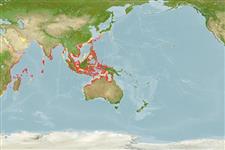Environment: milieu / climate zone / depth range / distribution range
Ekologi
laut berasosiasi dengan karang; nir-ruaya; kisaran kedalaman 1 - 30 m (Ref. 89707), usually 1 - 15 m (Ref. 90102). Tropical; 36°N - 34°S, 30°E - 143°E (Ref. 5222)
Indo-West Pacific: western India to Philippines, north to southern Japan (Honshu), south to northern Australia. 'Epinephelus formosus' from Madagascar (Ref. 6457), Réunion and Mauritius (Ref. 6458) are probably based on misidentifications of Cephalopholis polleni. Confused with Cephalopholis boenak.
Length at first maturity / Size / Weight / umur
Maturity: Lm 17.0 range ? - ? cm
Max length : 34.0 cm TL jantan/; (Ref. 4787)
Duri punggung (Keseluruhan (total)): 9; duri punggung lunak (Keseluruhan (total)): 15-17; Duri dubur 3; Sirip dubur lunak: 7 - 8. Characterized by: dark brown to yellowish brown color with narrow blue stripes; body with ctenoid scales, including abdomen; greatest depth of body 2.5-2.9 in SL; rounded caudal fin; pelvic fins, 1.6-2.0 in head length (Ref. 90102): head length 2.4-2.6 in SL; preorbital depth 3.6-4.3% SL, more than half maxilla width; convex interorbital area; rounded preopercle, finely serrate, lower edge fleshy; smooth subopercle and interopercle; maxilla naked, reaching to or just past vertical at rear edge of eye (Ref. 089707).
Like C. boenak, it prefers shallow dead or silty reefs and this may account for the primarily continental distributions of these two species. Solitary (Ref 90102).
Heemstra, P.C. and J.E. Randall, 1993. FAO Species Catalogue. Vol. 16. Groupers of the world (family Serranidae, subfamily Epinephelinae). An annotated and illustrated catalogue of the grouper, rockcod, hind, coral grouper and lyretail species known to date. Rome: FAO. FAO Fish. Synop. 125(16):382 p. (Ref. 5222)
Status IUCN Red List (Ref. 130435)
ancaman kepada manusia
Harmless
penggunaan manusia
Perikanan: perikanan swasembada
informasi lanjut
AcuanBudidaya airprofil budidaya airStrainGenetikaElectrophoresesDiturunkanPenyakit-penyakitPengolahanNutrientsMass conversion
mitraGambarStamps, Coins Misc.Suara-suaraCiguateraKecepatanTipe renangArea insangOtolithsOtakPenglihatan / visi
Alat, peralatan
laporan khas
muat turun XML
Sumber internet
Estimates based on models
Preferred temperature (Ref.
123201): 26.5 - 29.3, mean 28.7 °C (based on 2081 cells).
Phylogenetic diversity index (Ref.
82804): PD
50 = 0.5000 [Uniqueness, from 0.5 = low to 2.0 = high].
Bayesian length-weight: a=0.01000 (0.00620 - 0.01613), b=2.97 (2.84 - 3.10), in cm total length, based on LWR estimates for this species & Genus-body shape (Ref.
93245).
Trophic level (Ref.
69278): 4.1 ±0.7 se; based on size and trophs of closest relatives
Daya lenting (Ref.
120179): sedang, Waktu penggandaan populasi minimum 1.4 - 4.4 tahun (Fec = 80,208).
Fishing Vulnerability (Ref.
59153): Low vulnerability (24 of 100).
Nutrients (Ref.
124155): Calcium = 54 [30, 97] mg/100g; Iron = 0.577 [0.329, 1.080] mg/100g; Protein = 18.5 [16.7, 20.2] %; Omega3 = 0.16 [0.10, 0.25] g/100g; Selenium = 29.7 [16.5, 50.7] μg/100g; VitaminA = 181 [65, 556] μg/100g; Zinc = 0.823 [0.596, 1.337] mg/100g (wet weight);
